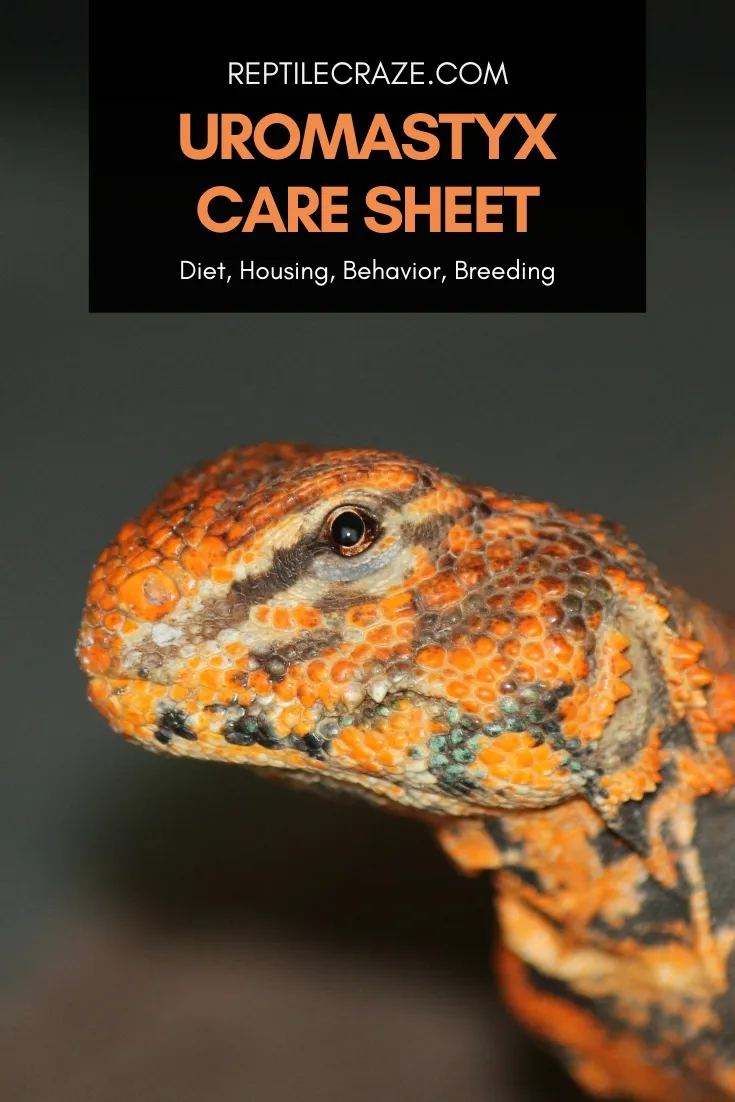
The uromastyx is an interesting reptile with a unique feature: its spiny tail. This spiny-tailed lizard is great for beginners and intermediate reptile owners who want a fun pet that they can play with and handle.
For more information on how this pet fares in captivity, here is what you need to know about the uromastyx.
Table of Contents
Uromastyx Facts
| Common Name | Uromastyx, Spiny-tailed lizard |
| Scientific Name | Uromastyx (with several subspecies like the ornanta, aegyptia, acanthinura, ocellata, and more) |
| Natural Habitat | Desert of Northern Africa and Middle East |
| Adult Size | 10 to 36 inches |
| Enclosure Size | 5’ x 2’ x 2’ |
| Diet | Leafy greens, vegetables, occasional insects |
| Lifespan | Up to 20 years |
| Experience Level | Beginner to intermediate |
Where Do Uromastyx live?
This particular reptile hails from the desert regions of Northern Africa and their habitat reaches into the Middle East.
As you might imagine, this means that they prefer dry climates with low levels of humidity in their enclosure, though they often favor rocky areas as well.
Uromastyx Reptile Appearance + Colors/Morphs
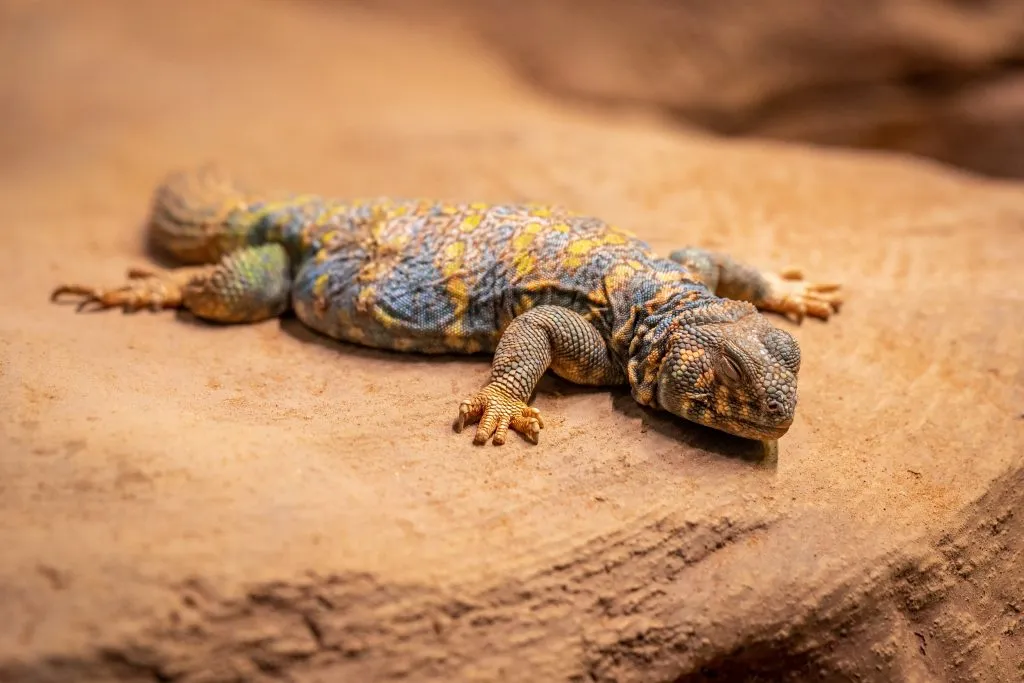
The Uromastyx is relatively easy to identify as it has a signature feature: the spiny tail for which it is sometimes named (the spiny-tailed lizard). The tail takes up roughly a third of its body size, making it a prominent feature.
When it comes to color, you might be surprised to learn that this species of lizard has some fairly bright colors. Some species will be dark blue or green in color with accents of orange or yellow.
This is particularly true of the males, which often have brighter colors than the females. Females tend to have dull colors and stick mostly with grays and browns.
The color of the reptiles will change depending on temperature of the enclosure. Winter months when temperatures are lower usually result in darker and more faded colors while summer and warmer weather lightens them up.
How Big Do Uromastyx Get?
The overall size of your spiny-tailed lizard will depend on which specific species you decide is right for you. The smaller varieties such as the Hardwicki will only grow to be about ten inches long.
On the other hand, the Egyptian Uromastyx will grow to be more than three feet in length, though this is less common than the smaller reptiles.
Did you know? Uromastyx grow out of their skin and shed quite often!
Uromastyx Lifespan
If you are diligent about taking excellent care of your uromastyx, then you will be rewarded with a reptile who lives a long time.
These reptiles are known for living up to twenty years in captivity with the proper care and maintenance.
How to Care for Uromastyx
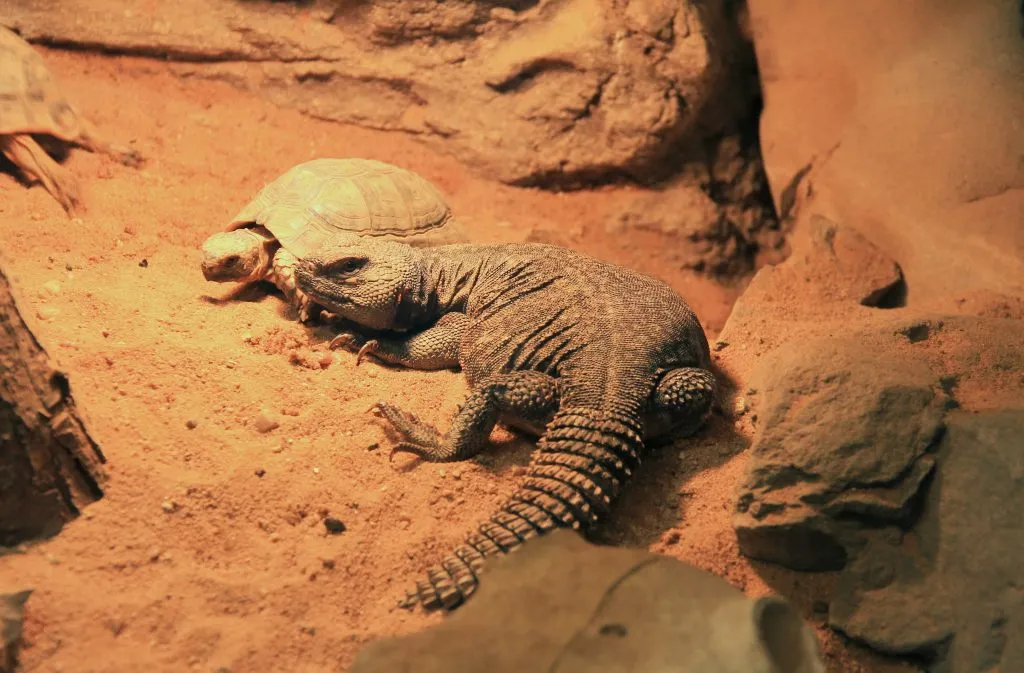
Uromastyx Tank Setup
To make your reptile comfortable, you will need a fairly large enclosure (especially if you have one of the larger species of uromastyx).
A smaller species or a juvenile reptile can make do in a simple 20-gallon aquarium, though a larger one is always better.
Not to mention, having a larger enclosure from the beginning can save you the investment of buying another enclosure months down the road.
Once your uromastyx is full-grown, it will need space to roam and reach its full size. To this end, you should get an enclosure that measures a minimum of five feet long with a standard two-foot width and height.
Lighting and Temperature
One of the most important aspects of setting up your enclosure is getting a temperature gradient that suits your reptile.
The cool side should be roughly 80 degrees Fahrenheit while maintaining a basking spot that reaches up to 120 degrees Fahrenheit. For the basking spot, you can use the Exo Terra Solar Glo or the Zoo Med Powersun.
Keep in mind that this reptile is diurnal, meaning that you will need to simulate day and night. The lights should be kept on during the day for roughly twelve hours and they should be in the darkness for roughly the same amount of time.
At night, you can use an under tank heater like this one to keep the temperature high without the light.
Do Uromastyx Need UVB?
In order to process calcium properly, your uromastyx will need UVB during the daylight hours. To this end, you can combine your heating and UVB into one convenient lamp with the Exo Terra Solar Glo.
These bulbs come with a one-year warranty, so while they are a bit expensive, they will last your uromastyx for a while.
Substrate
Because these are desert-dwelling reptiles, you won’t want any type of substrate that clings to moisture such as coconut fiber. Instead, you should opt for sand like the Exo Terra Desert Sand.
Some people like to mix this with soil to give the most natural habitat, allowing them to burrow as they do in the real world.
A little bit of clay like the Zoo Med Excavator Clay will allow them to burrow more easily, but keep the ratio low (about 10 percent clay).
Humidity
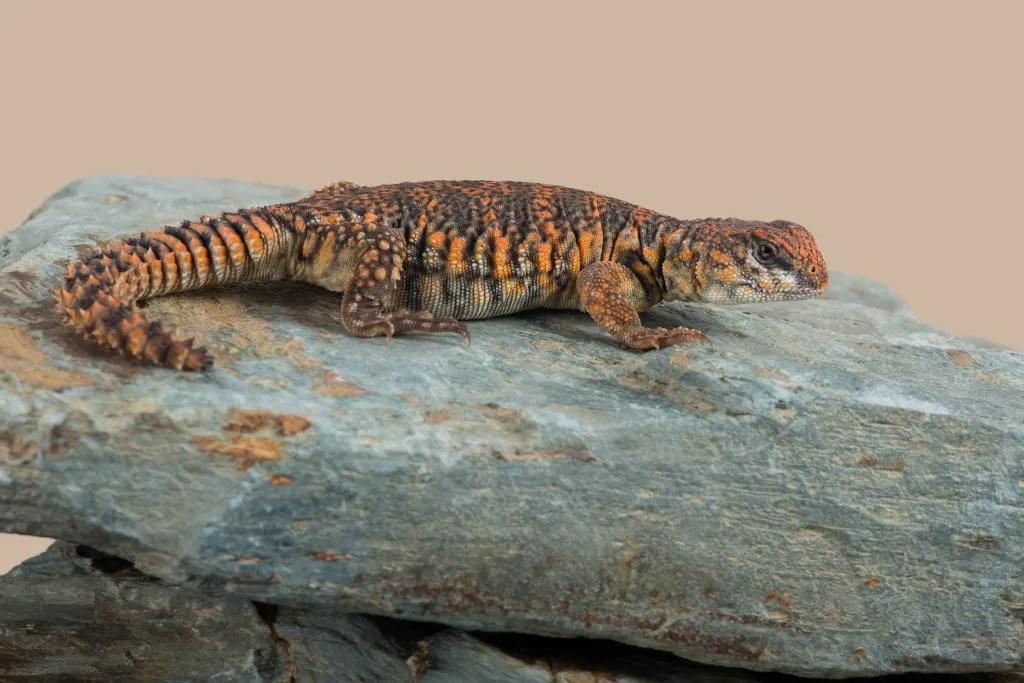
Because of their desert origins, it likely comes as no surprise that the uromastyx prefers to keep the humidity low. In fact, your hygrometer should read at less than 35 percent at all times.
This means that you should never mist their enclosure, allow spills, or keep too much water in their enclosure. If the humidity rises, you can increase air circulation to diffuse some of the moisture levels.
Uromastyx Tank Décor
First and foremost, your uromastyx is going to require a basking rock for under their heat lamp.
This Zilla Shale Rock Den is a great option because they can climb on top to bask or hide under the rock, as these reptiles tend to like cozy spaces.
A hide on the cool side of their enclosure is also a must-have item, so look for options like this bark hide.
They also love to climb, so adding in some fun mopani wood items is a great option to keep them active and happy.
Plants can also provide some shade, but stick with those that have weighted bottoms like this fern from Exo Terra.
How to Clean a Uromastyx Tank
For the most part, you can clean your uromastyx
You should deep clean once every week or two, removing the substrate and laying down fresh. You can clean the enclosure itself with water and vinegar.
Uromastyx Diet
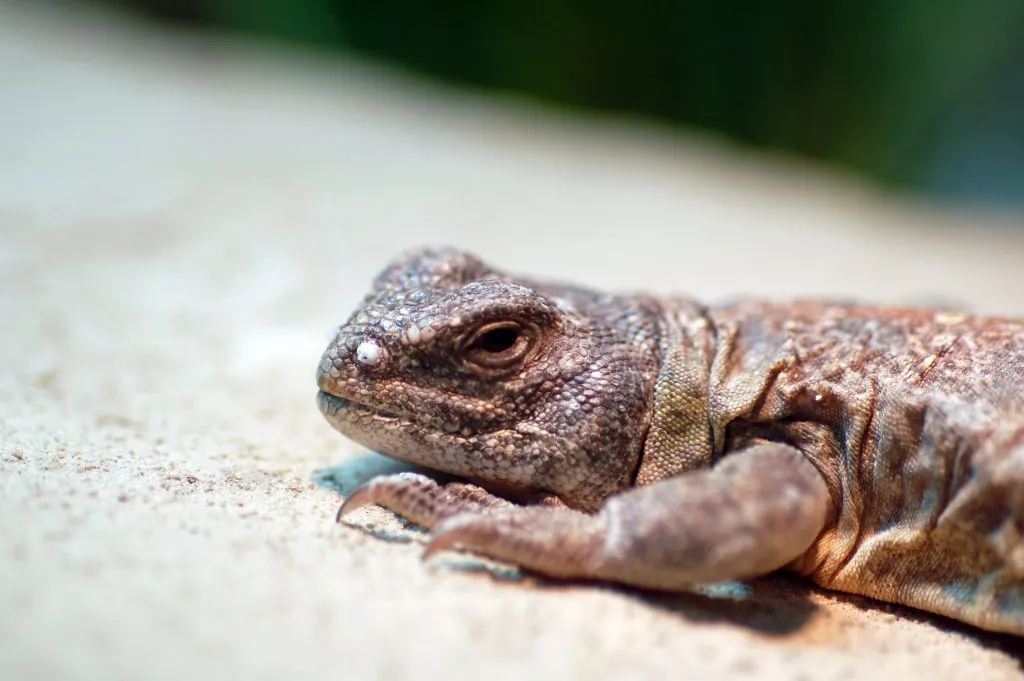
What to Feed
To keep your uromastyx healthy, they will need a combination of plants and insects. For the most part, they can get everything they need from plants, so this should be where you focus your time and attention.
They love leafy greens and other vegetables, so experiment with different salads to see what your reptile prefers.
Some of the most popular foods to feed include:
- Lettuces or arugula
- Sweet potatoes
- Corn
- Peas
- Carrots
- Collard greens or mustard greens
- Dandelions
From time to time, you can also share a few crickets or mealworms with them but it should not be the bulk of their diet.
How Often to Feed
Most reptile owners will want to feed their uromastyx daily, especially if they are young. After they reach the two-year mark, you can switch to feeding every other day or five days each week.
If you plan to feed them daily, keep their salad mixtures small to prevent them from gaining too much weight.
How Long Can They Go Without Food ?
While it is ideal to feed your uromastyx several times per week, they are naturally inclined to go without
They could go up to two months without eating during a period of brumation (usually in the winter months).
Do Uromastyx Need Water?
You want to be careful with how much water you introduce into their enclosure, as it can raise the humidity level. Most of the water that your reptile needs will come from its diet of veggies and plants.
That being said, you should still include a small dish of water as an option for them to drink if and when they need to.
Vitamins and Minerals
For the most part, uromastyx do not need any additional vitamins and minerals added to their diet. If you are concerned, you can dust one to two meals each week with some calcium powder or a multi-vitamin. However, you should not do this at every meal.
Uromastyx Behavior and Temperament
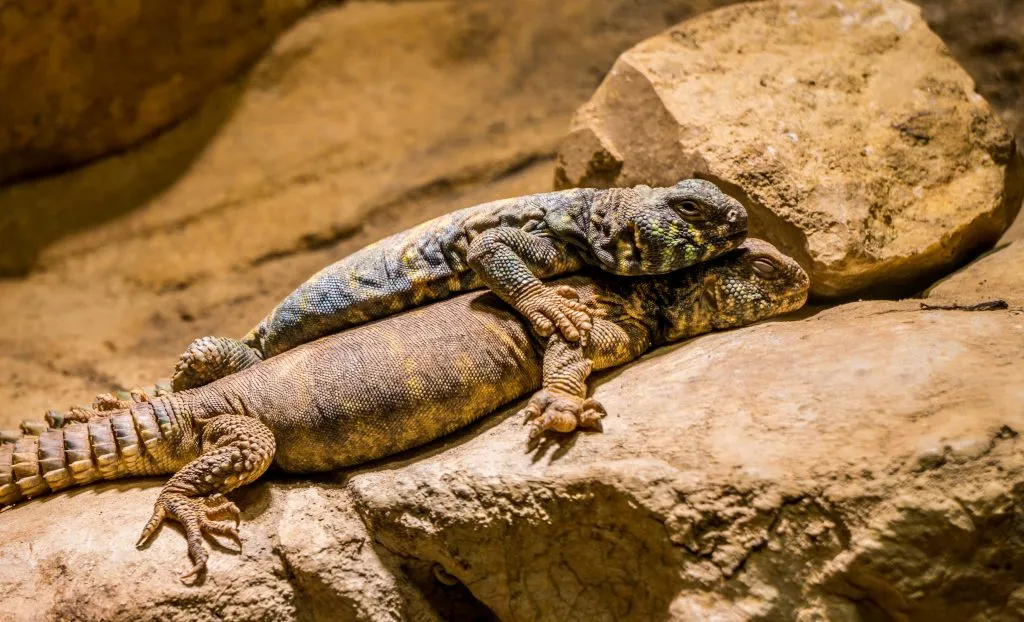
When you first bring your uromastyx home, you might find that it spends majority of its day in its hides, away from your view.
Give it time to adjust to a new setting, and you will find these reptiles to be quite friendly. For the most part, they are very docile once they are accustomed to being handled.
That being said, an uromastyx that feels threatened can and will bite which can be painful. They also have the ability to lash out with their spiky tail.
It’s best to allow them to adjust to their new surroundings and your presence before you start trying to handle them.
Are Uromastyx Good Pets?
In general, the uromastyx makes a good pet for beginners to intermediate reptile owners.
If you take the time to do your research, get the proper enclosure setup, and are committed to getting your uromastyx settled and comfortable, then you will do just fine.
They are known for being a more docile reptile which makes handling easy.
Can You Handle Uromastyx?
If you want to handle your uromastyx, then you will need to put in the work upfront to get them to trust you.
Spend time with your hand in the enclosure so that they can get used to your smell and your presence. After a week or two of doing this, you can start trying to feed them by hand which can be enjoyable for both of you.
When your reptile is at ease with you, you can start trying to pick them up for short periods of time. Let this be a short and pleasant experience for both you and your reptile.
Keep your hands away from their tail, as this can make them feel threatened and they may lash out at you with it – which can be quite painful!
Uromastyx Common Health Problems
For the most part, uromastyx are easy to take care of and are not prone to major health issues with the proper care and maintenance.
As long as they have UVB lighting in their enclosure, they should be at low risk of developing metabolic bone disease. This is a major health concern that makes the bones brittle in their bodies.
Struggling with the humidity levels in your
Humidity can also contribute to respiratory infections that make it challenging for your reptile to breathe freely and can be deadly without treatment.
Where to Buy Uromastyx
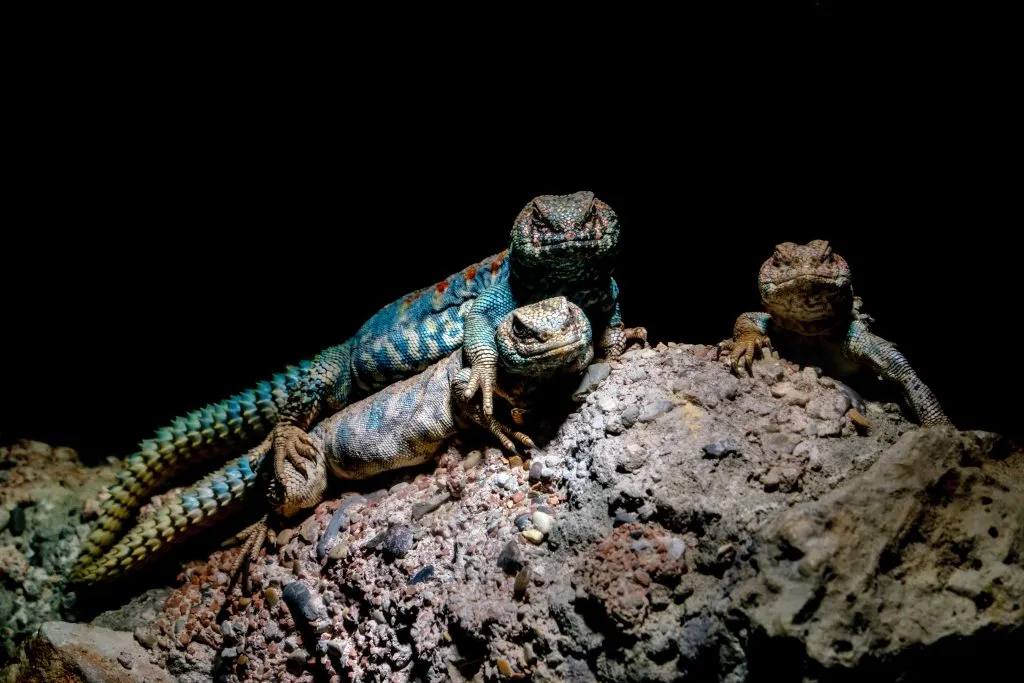
Uromastyx Breeders
If you want to invest in a quality uromastyx, then you need to reach out to one of the top breeders in the country. Some of the top breeders you might want to look into include:
Uromastyx Price
The price on a uromastyx depends on the variety of reptile that you are looking at. You could pay anywhere from $70 to $80 for more common varieties while less common varieties may run you from $150 to $300.
Some species will be even more expensive than this, though it is less common to see prices in excess of $300.
Uromastyx Breeding
If you intend to breed your uromastyx, it can be relatively easy though a bit on the aggressive side of things.
Males who are determined to breed with a female will bite and oftentimes pull the female around the enclosure before they actually climb on top and mate with her.
Females will lay the eggs roughly four weeks later, often in clutches of ten to twenty eggs.
Eggs should be kept in a cool part of the cage, usually in a box that keeps them separate from the rest of the enclosure.
You can incubate them at a high temperature, and most eggs will hatch about two months after they are laid.
Final Thoughts
If you are considering adding a reptile to your home, the uromastyx can be easy to care for with a little bit research. Consider whether this reptile is the right fit for you with these fun facts and care tips.
- Enchi Ball Python: A Unique and Stunning Morph of Python regius - March 27, 2025
- Emerald Tree Monitor: The Enigmatic Green Guardian of the Rainforest - March 26, 2025
- The Egyptian Cobra (Naja haje): A Fascinating Serpent - March 25, 2025
